This visit we stumbled across a new, and very superior, cioccolateria, in the San Polo sestiere of the city. There was a lot of polished copper and delicious aromas but, with each chocolate costing almost €2 apiece, relatively little chance of over-indulging!
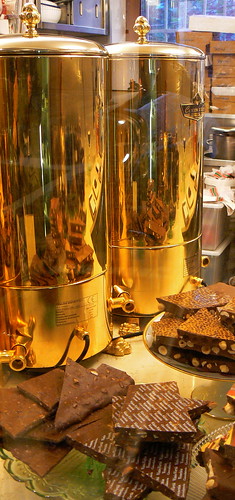
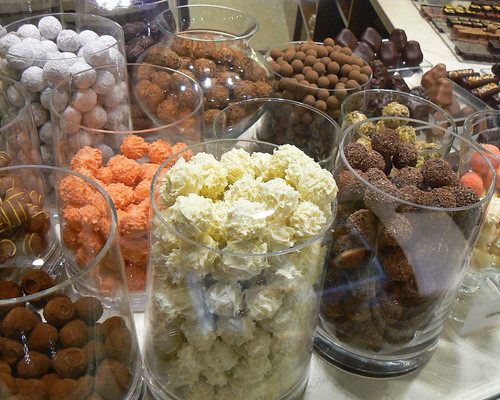
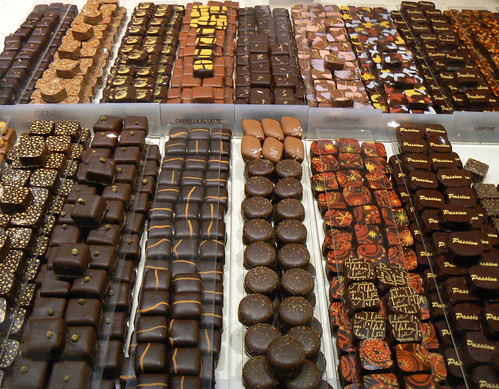
Not quite so posh, but perhaps more honest and certainly irresistible to any passer-by with an even faintly sweet-tooth, are the everyday sweet shops that are in evidence all over Venice.
Now, these really are sweet shops!
Instead of the serried rows of chocolates, there is a pleasing jumble of bowls filled to overflowing with brightly-coloured or brilliantly-wrapped sweets of all kinds and sorts.
These are the kind of establishments that you imagine from memories of childhood fiction. Of course, outside of picture book illustrations and fanciful jigsaw paintings, I doubt if such shops ever existed in Britain, but they most certainly ought to have done, because they are exactly the kind of places where one imagines William Brown, Billy Bunter and Jennings and Derbyshire would have gone to stock-up on essential sweet supplies.
They are positively Dickensian in their joyful appearance and riotously opulent excessiveness and could easily have provided the inspiration for the confectionery business overseen by Mr Willy Wonka or, more recently, for Honeydukes sweetshop in J K Rowling's Hogsmeade village.

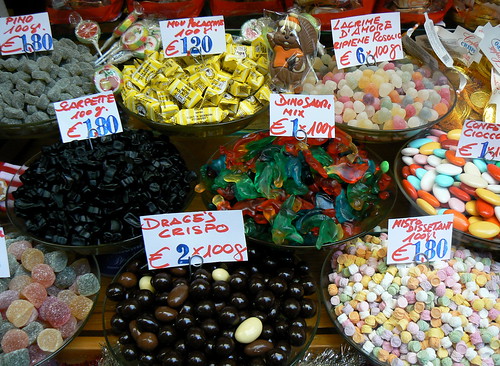
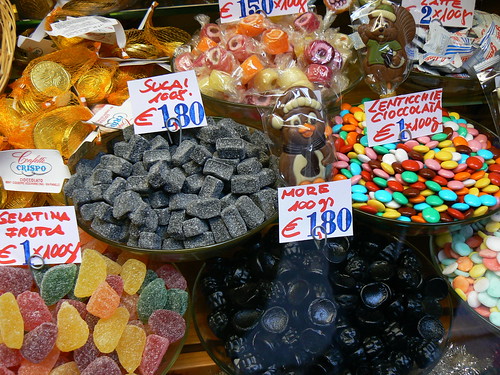
Without a doubt, we would all be a good deal happier (though undeniably fatter) if we all had a branch at the end of our street!
9 comments:
Sweets to the sweet -- did you at least try one of the Euro-a-Choc sweets? Are they worth it? And was that where Buttons was indulging in that marvelous-looking cup of chocolate?
The others look wonderful, as well. Alas, I can only look, but I shall feast my eyes.
We did! We had two each in little fancy, gold-lined boxes! David had a truffle and a coffee flavoured chocolate, I had a pistachio and (my favourite) marzipan. Quite delicious but barely a mouthful!
The hot chocolate drink was at Florian's Gran Caffe in Saint Mark's Square and was even more expensive than than the €1 chocolates!
At the other shops, of course, you can get a whole bag of sweets for a Euro!
But I should imagine the Government would intervene if there were lots of sweet shops at street corners.
And it certainly wouldn't do either you or me any good on the health front - though if perhaps there was a means of rationing treats to a couple a day it might actually have health benefits.
What beautiful displays - I love the one marked "carbone"!
Have you ever been to Brussels Brian? This is the real place for proper chocolate.
bretshne: the smell of your breath after having indulged in chocolates and sweets of every kind!
SHARON M - Puritanical Gordon Brown probably would! So would those Tory nannies! But are we adults or children?? OK, I withdraw that last question...
SUZANNE - Yes, I must visit Brussels one day - and not just in order to sample the chocolate.
The thing about the 'Carbone' sweet (black sugar lumps of 'coal') is that this is what you put in the Santa stockings of children who have been bad (or, presumably, not totally good) during the preceding year. These stockings are left not on Christmas Eve but on Epiphany (January 6th) and are delivered not by St Nicholas (or his doubles) but by La Befane.
In Spain the coal is for the children who have been naughty during the year, of course the coal is black sugar in a little sanbag, but here is the "gift" of the Wise Men in the nigth of January 5th.
I'm wondering where began this tradition of the coal for the bad childs.
EUDORA - I'm not sure when the tradition of giving coal to naughty children began, but it clearly goes back hundreds of years and is referred to in one source I consulted as "a punishment and an admonition to behave better in the year ahead". Alternatives to coal apparently included onions, garlic and carrots. Obviously, the coal was, originally, real as opposed to the modern sugar variety, but then - in those days - 'good' children (especially among the poor) would probably have only had such presents as sweets, nuts and fruit.
Here are a couple of versions of La Befane's story.
Well Brian, thank you for the information. I just find some notes but without historical source, if someday I found more information, I'll give you.
This is my translation of a little story of a web of "mineral coal", sorry for the posible grammatical errors:
"The origin of this tradition seems to be in the Carbonilla (Cinders), a character of the mythology of Christmas. This one, supposedly, would be one of the page boys of the Magi, entrusted to monitor the children all the year round to know if they have been good or bad. Cinder would be the responsible of the "reports" to the Magi, of saying what children were deserving toys and which not. Because of this, whenever a child was behaving himself badly, the parents were warning him, or her, that Carbonilla would be visit him, or her, instead the Wise Men bringing coal instead of his presents or toys.
Another explanation of this tradition is that the first moment the presents of the Magi were limiting to needs of the daily life, which were including the coal. Melchor was taking charge giving clothes or shoes; Gaspar was distributing delicacies, curd, honey or dried fruits and Balthasar was the "villain" of the group, punishing the children who had being bad, leaving coal or firewood to them."
Fascinating, EUDORA! Thank you. I do love the fact that, every now and again, this little blog leads us off into so many areas of discovery!
Post a Comment